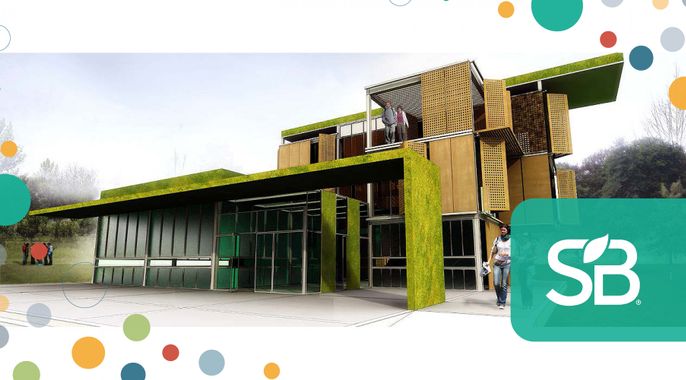Supply Chain, Jan 14, 2021
The intersection of circular practices and supply chain in the built environment will be a ripe area for innovation as companies look to their real estate portfolios for opportunities to meet their ambitious sustainability commitments by 2030.
The current supply chain of the built environment is defined by raw material extraction and landfill disposal. Therefore, a transition from linear to circular practices must start with challenging this paradigm. If we are to achieve a circular economy in this sector, we must ask:
- Where does the supply chain begin and end in terms of material input and output?
- Who is responsible for upstream and downstream activities in the system of production?
- What accountabilities are factored into the activities of suppliers, producers and consumers?
Beginning with the basics
To better understand how the creative collision between a circular economy and supply chains can drive innovation in the built environment, let’s begin with a few basic definitions.
According to the Ellen MacArthur Foundation, a circular economy is based on the principles of designing out waste and pollution, keeping products and materials in use, and regenerating natural systems. Compared to a linear economy of “take-make-waste,” a circular economy is based on “reduce-reuse-recover” strategies for materials in closed-loop systems. In a linear economy, resources are taken from the ground to make products which are used until no longer needed, at which point they are discarded — i.e., “thrown away.” The circular economy, however, acknowledges that there is no place on our planet called “away” to responsibly dispose of these products. Thus, in a circular economy, products and services are designed with materials that are upcycled or recycled at the end of their useful life.
According to the Center for Management Terms & Practices, supply chain is defined as “the optimized flow of products and services from their origin, through one’s facilities, on to consumption and then disposal.” Key concepts in this definition are “optimized flow,” “origin,” “consumption” and “disposal.” Is “flow” optimized in linear paths or circular loops? Is the known origin of input materials based on responsibly sourced, transparent ingredients? Is the producer held accountable for end-to-end negative externalities with its products and services (i.e., pollution) from supplier to consumer involvement? Is the consumer left as the responsible party for disposal or recycling at end of useful life? In a circular economy, the relationships between all stakeholders in the supply chain of a product’s lifecycle must be reconsidered. This higher expectation of responsibility applies to consumer products as well as whole buildings.
Introducing circularity into built environment supply chains
Making the shift from one-way, linear supply chains toward closed-loop systems requires innovative procurement practices based on business models and principles of a circular economy. The creative collision of a circular economy and supply chains in the built environment will change the ways that materials, products and services are specified and procured by the architecture, engineering and construction (AEC) industry.
According to a joint report by the Yale University Center for Ecosystems in Architecture and United Nations’ One Planet Network Sustainable Buildings and Construction Programme, “transitioning to a circular built environment requires the design of multi-beneficial policies that take a whole building life-cycle and systems-thinking approach.” What are the implications of such a whole building life-cycle and systems-thinking approach?
- Looping supply chains into value chains — A systems-thinking approach based on closed-loop systems — i.e., circular flows rather than linear paths — will shift conventional “input-output” thinking about everything from virgin materials to construction and demolition waste. Such circularity will require transparency and accountability for extending the value of materials, eliminating waste and negative consequences, and regenerating natural ecosystems. Players who can add cyclical value beyond providing a point solution for a segment in a linear supply chain will gain competitive advantage.
- Integrating information and stakeholders in value chains — A literature review on circular practices in the built environment by Munaro, Tavares and Braganca (2020) revealed the need for greater integration between stakeholders in the construction value chain. Digital transformation in delivery and operation of the built environment will accelerate the integration of all stakeholders, engaging them earlier and extending their involvement beyond the design stage into use and post-use stages. Building Information Modeling, Integrated Project Delivery, and new collaboration platforms such as the Concert Digital Exchange© enable multiple parties to advance solutions with a whole building life-cycle perspective. One barrier to such integration is the adversarial nature of multi-party relationships in conventional project delivery and obstacles to transparency of information. Such interoperability relies upon accessing manufacturers’ product information based industry standard product attributes — a focus of working groups such as Digital Supply Chains in Built Environment.
- New platforms for creating and exchanging value — The creation of circular solutions will require new forms of creating and exchanging value. The foundation of accounting practices, e.g., depreciation, is that buildings are objects that lose value through normal use. Such precepts do not account for the value of natural capital or ecosystem services. This raises questions about the value of building systems and material assemblies throughout a whole building life cycle. What if buildings were to be viewed as “banks” for depositing materials for the duration of their use, then the materials were withdrawn for a future reuse with preservation of value? For example, this is the foundational concept of Buildings as Material Banks bringing together fifteen parties throughout Europe with the mission of enabling a systemic shift in the building sector by creating circular solutions. Another example is the Circular Façades Platform that applies a “facades-as-a-service” business model to maintaining, repairing and reusing the exterior envelope or “skin” of a building.
The intersection of circular practices and supply chain in the built environment will be a ripe area for innovation as sustainability-focused companies look to their real estate portfolios for opportunities to meet their ambitious sustainability commitments by 2030 and beyond.







